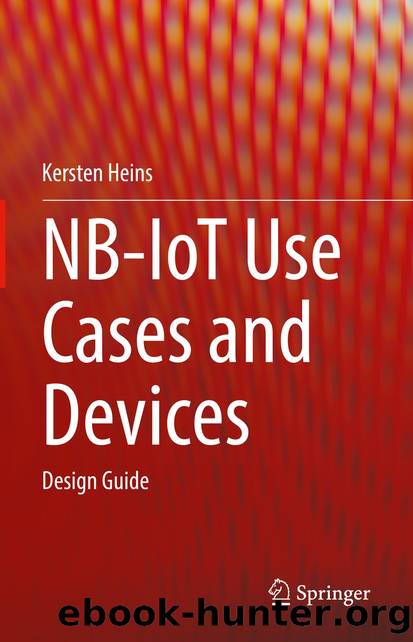NB-IoT Use Cases and Devices by Kersten Heins

Author:Kersten Heins
Language: eng
Format: epub
ISBN: 9783030849733
Publisher: Springer International Publishing
For uplink data transmission, the NB-IoT device must connect to the IP address of the recipient node first. After successful connection, the IoT application can submit uplink data via AT command to the modem. The modem can be configured to acknowledge successful data submission to the cellular network via related URC message to the IoT application.
MQTT (Message Queuing Telemetry Transport)
MQTT is a widely adopted standard in the Industrial IoT, for meters and detection devices and vehicles. It is a publication/subscription type messaging protocol. MQTT has been designed for communication in low-bandwidth networks, it has a small code footprint and requires low processing power and memory, i.e., an MQTT client running on an IoT device will cause only low-power consumption. The protocol usually runs over TCP/IP; however, any network protocol that provides ordered, lossless, bi-directional connections can support MQTT. The protocol is an open OASIS standard and an ISO recommendation (ISO/IEC 20922).
The MQTT protocol defines two types of network entities: a message broker and a number of clients. An MQTT broker is a server that receives all messages from the clients and then routes the messages to the appropriate destination clients. Information is organized in a hierarchy of topics. Whenever one of the clients has a new item of data to distribute, it sends a control message to the connected broker including the new data and associated topic. The broker then distributes the information to any clients that have subscribed to that topic.
A MQTT control message can be as little as two bytes of data, but can also carry nearly 256 megabytes of data if needed. There are 14 defined message types usedTo connect and disconnect a client from a broker,
Download
This site does not store any files on its server. We only index and link to content provided by other sites. Please contact the content providers to delete copyright contents if any and email us, we'll remove relevant links or contents immediately.
Exploring Deepfakes by Bryan Lyon and Matt Tora(8286)
Robo-Advisor with Python by Aki Ranin(8241)
Offensive Shellcode from Scratch by Rishalin Pillay(6386)
Microsoft 365 and SharePoint Online Cookbook by Gaurav Mahajan Sudeep Ghatak Nate Chamberlain Scott Brewster(5614)
Ego Is the Enemy by Ryan Holiday(5294)
Management Strategies for the Cloud Revolution: How Cloud Computing Is Transforming Business and Why You Can't Afford to Be Left Behind by Charles Babcock(4527)
Python for ArcGIS Pro by Silas Toms Bill Parker(4460)
Elevating React Web Development with Gatsby by Samuel Larsen-Disney(4181)
Machine Learning at Scale with H2O by Gregory Keys | David Whiting(4178)
Liar's Poker by Michael Lewis(3369)
Learning C# by Developing Games with Unity 2021 by Harrison Ferrone(3333)
Speed Up Your Python with Rust by Maxwell Flitton(3280)
OPNsense Beginner to Professional by Julio Cesar Bueno de Camargo(3251)
Extreme DAX by Michiel Rozema & Henk Vlootman(3236)
Agile Security Operations by Hinne Hettema(3160)
Linux Command Line and Shell Scripting Techniques by Vedran Dakic and Jasmin Redzepagic(3151)
Essential Cryptography for JavaScript Developers by Alessandro Segala(3122)
Cryptography Algorithms by Massimo Bertaccini(3057)
AI-Powered Commerce by Andy Pandharikar & Frederik Bussler(3022)
